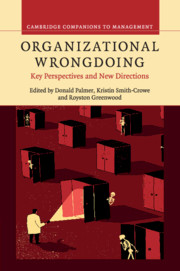Book contents
- Frontmatter
- Contents
- List of figures
- List of tables
- List of contributors
- Foreword
- 1 The imbalances and limitations of theory and research on organizational wrongdoing
- 2 On taking the theoretical substance of outcomes seriously: a meta-conversation
- 3 Wrong paths to right: defining morality with or without a clear red line
- 4 From market enablers to market participants: redefining organizational and political-legal arrangements and opportunities for financial wrongdoing,1930s–2000
- 5 Wrongdoing and market development: an examination of the distinct roles of trust and distrust
- 6 Bad apples, bad barrels and bad cellars: a “boundaries” perspective on professional misconduct
- 7 S/he blinded me with science: the sociology of scientific misconduct
- 8 Social networks and organizational wrongdoing in context
- 9 Falling stars: celebrity, infamy, and the fall from (and return to) grace
- 10 Compensation and employee misconduct: the inseparability of productive and counterproductive behavior in firms
- 11 Beware of organizational saints: how a moral self-concept may foster immoral behavior
- 12 “Is it me? Or is it me?” The role of coactivated multiple identities and identifications in promoting or discouraging workplace crimes
- 13 Consequences of organizational misconduct: too much and too little punishment
- 14 Who bears the brunt? A review and research agenda for the consequences of organizational wrongdoing for individuals
- 15 Organizational wrongdoing and media bias
- 16 Ethical learning: releasing the moral unicorn
- Index
- References
2 - On taking the theoretical substance of outcomes seriously: a meta-conversation
Published online by Cambridge University Press: 05 July 2016
- Frontmatter
- Contents
- List of figures
- List of tables
- List of contributors
- Foreword
- 1 The imbalances and limitations of theory and research on organizational wrongdoing
- 2 On taking the theoretical substance of outcomes seriously: a meta-conversation
- 3 Wrong paths to right: defining morality with or without a clear red line
- 4 From market enablers to market participants: redefining organizational and political-legal arrangements and opportunities for financial wrongdoing,1930s–2000
- 5 Wrongdoing and market development: an examination of the distinct roles of trust and distrust
- 6 Bad apples, bad barrels and bad cellars: a “boundaries” perspective on professional misconduct
- 7 S/he blinded me with science: the sociology of scientific misconduct
- 8 Social networks and organizational wrongdoing in context
- 9 Falling stars: celebrity, infamy, and the fall from (and return to) grace
- 10 Compensation and employee misconduct: the inseparability of productive and counterproductive behavior in firms
- 11 Beware of organizational saints: how a moral self-concept may foster immoral behavior
- 12 “Is it me? Or is it me?” The role of coactivated multiple identities and identifications in promoting or discouraging workplace crimes
- 13 Consequences of organizational misconduct: too much and too little punishment
- 14 Who bears the brunt? A review and research agenda for the consequences of organizational wrongdoing for individuals
- 15 Organizational wrongdoing and media bias
- 16 Ethical learning: releasing the moral unicorn
- Index
- References
Summary
As the large number of review articles in recent memory demonstrates, research on behavioral ethics in organizations has exploded (e.g., Bazerman and Gino 2012; Kish-Gephart, Harrison, and Treviño 2010; Tenbrunsel and Smith-Crowe 2008; Treviño, den Nieuwenboer, and Kish-Gephart 2014; Treviño, Weaver, and Reynolds 2006; Weaver, Reynolds, and Brown 2014). Scholars in this area focus on individuals’ ethical judgments, decisions, and behaviors, particularly those relevant to organizations. Treviño and colleagues (2014) trace the beginnings of this field to the 1980s and describe the overall endeavor like this: “Most research in the field begins with the premise that ethical behavior in organizations is good and unethical behavior is bad, and that understanding the predictors of each can help organizations produce more of the former and less of the latter” (p. 637). We find this description to be not only apt but also illuminating. It highlights something that those of us working in this area seem to take for granted: our theoretical focus should be on the predictor side of the model. While we struggle to achieve a degree of parsimony out of the kaleidoscope of possibilities on the predictor side of the equation, we tend to keep things simple on the criterion side (i.e., the outcomes we study). There is ethical and unethical. Usually, we focus on predicting unethical outcomes.
The cost of relative inattention to theory development on the criterion side is ultimately an impoverishment of theory more generally. We often vaguely refer to “unethical” behavior without acknowledging the potential for conceptual complexity. Such complexity surely holds implications for theorizing on the predictor side. In the long run, we cannot expect our theories to systematically connect predictors with outcomes when we have not specified the nature of the outcomes. Our contention is that, to the end of systematic theorizing, as a field we should take the theoretical substance of outcomes seriously, meaning that we should focus theory development not only on the predictor side of the equation but also on the criterion side.
In order to support our contention, we report the results of a somewhat unconventional literature review. First, we review the outcomes employed by those studying behavioral ethics in organizations. Though there are numerous reviews to date, they are organized around the predictors of unethical outcomes.
- Type
- Chapter
- Information
- Organizational WrongdoingKey Perspectives and New Directions, pp. 17 - 46Publisher: Cambridge University PressPrint publication year: 2016
References
- 5
- Cited by

